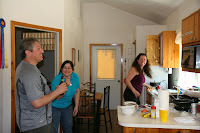For many of us animal trainers, the idea of hitting a horse or a dog went out with the dark ages. We know the benefits of positive but firm discipline. Discipline should be about teaching how to do better in the future. Hitting, belting, whipping and screaming will generally shut down the ability to learn. Physical punishment does not promote respect, but encourages anger and aggression. In the short term, the undesired behavior may stop but in the long term, the animal is likely to exhibit post-traumatic stress and behavioral issues.
I watched the documentary “Buck” last night, which is about a horse trainer that specializes in positive training. Tears came to my eyes when he and his family spoke of the beatings he received as a child and how he was removed from his father's home at age twelve. Now, this is an extreme example of corporal punishment but I think many of us can relate to what the effects of physical punishment can do to a child and how those effects can last a lifetime. There are plenty of scienfitic studies that show that adults who received corporal punishment suffer from depression, suicide and mental illness at significantly higher rates than those who didn’t receive corporal punishment.
Children do not need to be hit, slapped or spanked or even yelled at to learn, to respect and to model responsible behavior. My own children were never spanked, they weren’t yelled at and in turn, they never hit others, never yelled and but instead respected other people. I know that I did right when I chose not to model my own parent’s tough parenting techniques. Because, yes I was hit often and yes, it took me years to overcome my emotional wounds. And yes, I did have post-traumatic stress syndrome.
Now, I know that the people who need to hear this message, will snicker and make rude comments but I write this because if just one person really thinks about and changes how they are raising their child or will raise their child, the world will be a better place.
If you don’t beat or spank or yell at your horse, why would you do it to your kid?
A few references:
Also Chapter 5 in Murray A. Straus, Beating the Devil out of them: Corporal Punishment in American Families And its Effects on Children. New Brunswick, NJ: Transaction Publications. 2000.
Bulletin of the World Health OrganizationSevere physical punishment: risk of mental health problems for poor urban children in Brazilhttp://www.who.int/bulletin/volumes/87/5/07-043125/en/index.html













